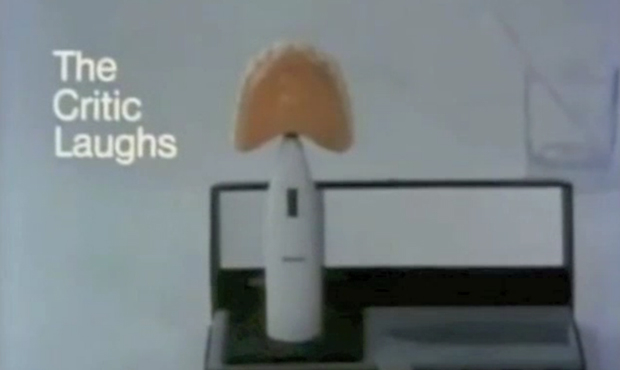Matt Trueman: Do critics laugh?
Matt Trueman discusses the difficulties of having to be professionally sceptical

© Johan Persson
In 1968, the pop artist Richard Hamilton attached a pair of dentures to the body of an electric toothbrush. When you turned the toothbrush on, the teeth would start a constant, clockwork chatter. He called it The Critic Laughs.
The piece came packaged in plastic, like any other consumer product of the time, and Hamilton created a television commercial, replicating the tacky, Brylcreamed gloss and perfect smiles of contemporary advertising. "For the connoisseur who has everything," the voiceover purred, "at last, a work of art to match the style of modern loving."
There's something deathly about this object – these disembodied teeth rattling away for no reason, like a twitching corpse or a headless chicken. Detached dentures recall genocide and holocausts, but here they're repackaged as a luxury item, an energy-saving convenience. Even that's perverse. Hamilton's machine automates a natural activity. It outsources something pleasurable. It fakes something human. Hence that title: The Critic Laughs.
The truth is we don't – not like other people. At the risk of cementing the image of the joyless critic, sat stony-faced in the stalls, criticism is kind of at odds with laughter. The two aren't incompatible – we are capable of laughter, promise – but each is an obstacle to the other.
I say that after a week spent watching comedies – Miss Atomic Bomb, The Nap, The Painkiller. All these shows set out to make an audience laugh and, to some extent, succeed or fail on that basis.

Any critic will tell you, reviewing comedy is hard. It's not just that everyone has their own sense of humour – the same applies to taste, of course. It's something more integral, to do with the way we watch.
To be a critic is to process a piece of art. It is an analytical act, one that involves thinking about the artwork, figuring out its workings and assessing its success. As anyone will tell you, the single best way to ruin a joke is to explain it. If you lift up the bonnet of a good gag and deconstruct its mechanics, you render it instantly unfunny. But that's the critic's job, isn't it?
Not exactly. That notion of criticism presumes a level of objectivity – the critic blessed with specialist expertise and impeccable taste – where it's entirely subjective. Even so, the critic has to keep an eye on their own response – not just reacting to a piece of art, but assessing that reaction as it unfolds. Am I enjoying this show? Why? Why not? To be a critic is to be self-conscious.
Laughter is an involuntary action, a reflex response. Self-consciousness kills it dead. Trying to study laughter in lab conditions, the neuroscientist Robert Provine found that he struggled: "The problem is that laughter disappears just when you get ready to observe it."
Likewise, the critic keeping tabs on his or her own laughter can short-circuit their sense of humour. The moment you demand a laugh – go ahead punk, make me chuckle – you're putting your defences up. What do we say about humour? It can render us defenceless.
Laughter's also an embodied response, at odds with the heady task of analysis. To react viscerally to a piece of theatre, to feel it fully, you have to give in to it at some level. Just as Quentin Letts keeping track of time through Cleansed keeps that play's horrors at a distance, having a notebook on one's lap can disrupt the rhythm and flow of watching a comedy.
It's a social thing too – laughter is contagious. Part of being a critic, though, is being true to yourself, knowing your own mind, and that means resisting the sway of a crowd – especially on press nights, in an audience packed with well-wishers and interested parties. Again, we have to put our defences up. We're professionally sceptical – but that can get in the way.
All this isn't just to enhance my reputation as a humourless bastard, but to think about the sort of comedy that gets good reviews – because it's not as simple as best equals funniest.
Take The Nap and The Painkiller last week. Line for line, Richard Bean's snooker-loopy comic thriller is far funnier than Sean Foley's farce – and yet I rated the latter more highly. Why? I believed it, basically. Where The Painkiller follows its ludicrous situation – professional hitman and suicidal bloke in adjacent hotel rooms – through with unflappable logic, The Nap loses its grip on reality by including a transgender gangster with a bionic arm and a tendency to muddle words. The former gains momentum, upping its comic ante as Kenneth Branagh comes unstuck, no matter how many door slams and trouser drops you've seen before. The Nap, meanwhile, unravels into something like panto. Laughter, at some level, depends on credibility – it's funny because it's true.
Not all laughs are equal. Elegance and invention, commitment and, complexity all count for something – and critics are, I think, on the lookout for beauty, even in comedy. Gags can be easy or hard, soft or dangerous, lazy and old or startling and new – but all of those can be brilliant in their own right. The critic laughs, indeed.












